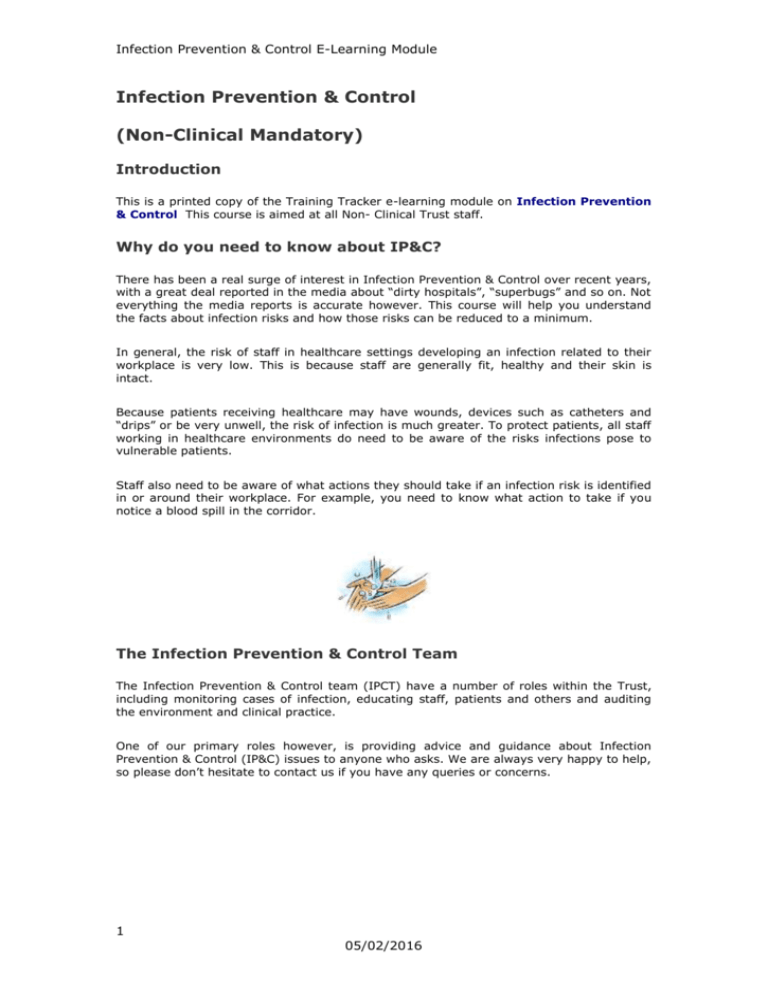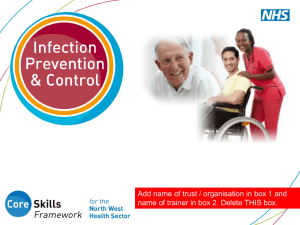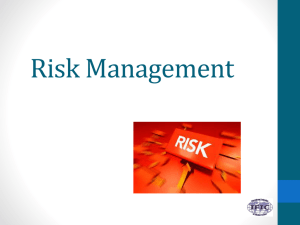Infection Prevention & Control 2010/13
advertisement

Infection Prevention & Control E-Learning Module Infection Prevention & Control (Non-Clinical Mandatory) Introduction This is a printed copy of the Training Tracker e-learning module on Infection Prevention & Control This course is aimed at all Non- Clinical Trust staff. Why do you need to know about IP&C? There has been a real surge of interest in Infection Prevention & Control over recent years, with a great deal reported in the media about “dirty hospitals”, “superbugs” and so on. Not everything the media reports is accurate however. This course will help you understand the facts about infection risks and how those risks can be reduced to a minimum. In general, the risk of staff in healthcare settings developing an infection related to their workplace is very low. This is because staff are generally fit, healthy and their skin is intact. Because patients receiving healthcare may have wounds, devices such as catheters and “drips” or be very unwell, the risk of infection is much greater. To protect patients, all staff working in healthcare environments do need to be aware of the risks infections pose to vulnerable patients. Staff also need to be aware of what actions they should take if an infection risk is identified in or around their workplace. For example, you need to know what action to take if you notice a blood spill in the corridor. The Infection Prevention & Control Team The Infection Prevention & Control team (IPCT) have a number of roles within the Trust, including monitoring cases of infection, educating staff, patients and others and auditing the environment and clinical practice. One of our primary roles however, is providing advice and guidance about Infection Prevention & Control (IP&C) issues to anyone who asks. We are always very happy to help, so please don’t hesitate to contact us if you have any queries or concerns. 1 05/02/2016 Infection Prevention & Control E-Learning Module The team are: Director of Infection Prevention & Control – Carol Alstrom Infection Control Doctor & Consultant Medical Microbiologist – Dr Suzanne Chapman Consultant Microbiologist - Dr Milada Tavodova The Infection Prevention & Control Nurses (IPCNs) – Janet Tait, Michelle Ould & Derek Bampton Secretary - Faye Blacklock Our Intranet home page with our contact details can be found by clicking this link (Intranet connected computers only) Your responsibility for IP&C Everyone is responsible for maintaining good IP&C standards. Contracted Trust staff have signed to indicate they will make themselves aware of and abide by relevant Trust policies, which include those relating to IP&C. All IP&C policies are available on the intranet policy site. To make them easier to find, they are all prefixed “Infection Prevention”. You can find the full list by following this link (Intranet connected computers only) Some of these policies will be more relevant for staff working directly with patients. Policies that are most relevant to you as a non-clinical staff member would be as follows; Code of practice Hand Hygiene Clean patient environment Disinfection and decontamination Safe handling & disposal of sharps Management of exposure to blood borne viruses The rest of this course will help you understand what you need to do to prevent infection in the workplace. 2 05/02/2016 Infection Prevention & Control E-Learning Module Hand Hygiene Hand hygiene is a vital part of preventing infection in a healthcare setting. This is because of the risk to vulnerable patients or clients. Hands pick up organisms from people, objects and environments and can then pass them on, unless they are removed by carrying out effective hand hygiene. The 'clean your hands' campaign was started to highlight the importance of hand hygiene. When the Trust joined the campaign, we made hand sanitizer widely available throughout the hospital, but most especially at the patient bedside, because the main message is to clean your hands before contact with vulnerable patients or clients. As healthcare staff, even if we do not work in patient areas, we need to be aware of the need to set a good example to others. Good hand hygiene is a good habit. Things to remember about hand hygiene Hand Washing; Always wet your hands before putting on liquid soap Make sure you rub soap vigorously over all surfaces of your hands including the backs, wrists and thumbs. Rinse and dry well. Use moisturiser to protect and nourish skin. Hand Sanitiser; Is effective at cleaning hands as long as there is no visible dirt on them Use one shot of sanitiser on dry hands •Rub it vigorously over all surfaces of the hands including the backs, wrists and thumbs until they are completely dry Sanitiser will not work against “gut bugs” and diarrhoea or vomiting (D&V) bugs – if you have used the toilet or have had contact with anyone with D&V, you need to wash your hands. 3 05/02/2016 Infection Prevention & Control E-Learning Module Hand Hygiene Products All hand hygiene products in use within the Trust must be approved for use. Our current products within the hospital are supplied by “Gojo” and have been tested to make sure they are safe for use in a healthcare setting. Some off-site Trust premises may have hand hygiene products supplied by “Deb”, which have also been tested for safety. If you believe the hand hygiene products we use are damaging your skin, it is very important you contact the Occupational Health team for a skin assessment. Do not simply bring in your own hand hygiene products – if they are not the approved products they are not allowed and may even be harmful to your hands. Occupational Health can advise you on suitable alternatives. Preventing the spread of infection Your own personal hygiene is very important in a healthcare setting, as it is possible for some common infections such as influenza and Norovirus to be brought into healthcare settings by staff. There are some simple measures you can take to minimise the spread of infection in the workplace. If you have sudden onset diarrhoea and/or vomiting and suspect you may have Norovirus, it is important to stay away from work until 48hours after the symptoms have stopped. It is very easy to pass this “bug” on to others, so please don’t put anyone else at risk by coming back to work too soon. If you have coughs, colds or flu, remember; “Catch it, bin it, kill it!” Use a tissue to “catch” the cough or sneeze, throw the tissue safely away in the bin immediately it has been used and wash your hands to kill the remaining “germs”. Always wash your hands after using the toilet and before you eat or drink anything. Common sense keeps us all safe! 4 05/02/2016 Infection Prevention & Control E-Learning Module Cleaning Cleaning is the physical removal of dirt and organisms. Everyone is responsible for cleanliness in their own workplace. The Cleanliness team are responsible for cleaning the environment, but they cannot be there all the time. In addition, they are not responsible for cleaning equipment on your desk or in your workspace such as computer keyboards, telephone handsets, electrical equipment and similar items. This is your responsibility. Everyone has a role to play in keeping the workplace clean. Detergent and water (or detergent wipes) are the most effective way to clean items. Cloths used for cleaning must be disposable and discarded once they have been used. Never leave dirty cloths lying about – organisms will grow in them! If you identify a problem related to cleanliness in your place of work, it is your responsibility to report it appropriately. The Hotel Services Manager can be contacted by phoning (53)4908. “Sharps” Safety Everyone needs to know what to do if they have a “sharps” or contamination incident whilst at work. A “sharps” incident, would be an injury from a contaminated sharp object such as a used scalpel or needle. A “contamination” incident would be a spill or splash of blood or body fluid onto broken skin or into the eyes, nose or mouth. It could also be a human bite that draws blood or a deep scratch from fingernails that are visibly contaminated with blood or faeces. These kinds of incident pose a risk of someone else’s blood getting inside your own blood system, which could put you at risk of developing a blood-borne virus. More information on this can be found on the Occupational BBV Refresher 2010/11 Training Tracker module for clinical staff. 5 05/02/2016 Infection Prevention & Control E-Learning Module What to do if there is a Sharps or Contamination incident. 1. Immediately start first aid 2. Report the injury to your supervisor/Line Manager 3. Follow the procedure on the sharps incident poster which you can find on the intranet Please make sure you are very familiar with the guidance on the poster. It is very important you access help quickly and correctly if an incident occurs. Reporting infection prevention & control issues When you work in a healthcare environment, it is possible for you to come across infection control issues that concern you but which you are not trained to deal with yourself. For example, it’s important to know how to get help if you find a used sharp in the toilets, a spillage of blood in a corridor or a bag of clinical waste in the grounds. Never put yourself at risk by handling used sharps or clinical waste – make the area safe, then contact switchboard (or phone direct) to ask for the most appropriate person. Laundry and waste issues should be reported to the Waste Manager or the Portering team. Used sharps and body fluid spills inside the hospital should be reported to the Caretaking team. Issues within the grounds of your place of work should be reported to the Estates team. 6 05/02/2016 Infection Prevention & Control E-Learning Module Infection Prevention & Control Infection Prevention and Control is everyone’s responsibility. If you have more questions, We will be happy to help you. you can contact the IPCNs from 9-5, Mon-Fri. Please contact the team on (01983)534882 What do I do now? – Access Training Tracker to take your test If you already have a username and password you can log into training tracker and start your test via this link http://iow.trainingtracker.co.uk that can be found on: Intranet Homepage Learning Zone E- Learning To obtain a username and password, please contact Development & Training on extension 5409, and we will ensure that the details are e-mailed to you as soon as possible, usually within 24 hours. If you have any difficulties with logging in please do not hesitate to contact us on the above number. IF YOU DO NOT FEEL CONFIDENT USING A COMPUTER AND WOULD LIKE ONE TO ONE SUPPORT AND GUIDANCE PLEASE CONTACT US ON THE ABOVE NUMBER AND WE CAN ARRANGE FOR AN IT TRAINER TO HELP YOU TO LOG ON AND TAKE YOUR TEST 7 05/02/2016







